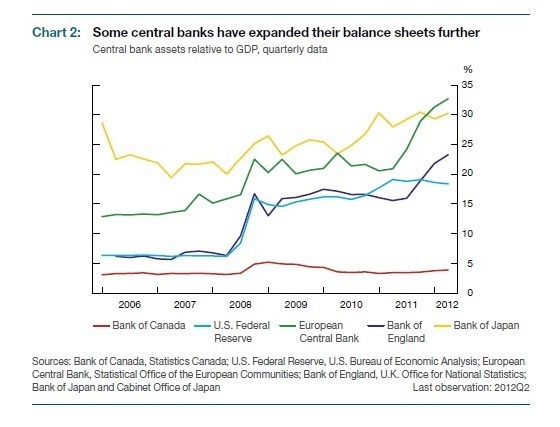David Larock in Mortgages and Finance, Home Buying, Toronto Real Estate News
When the Bank of Canada (BoC) released its latest interest-rate
statement last Tuesday it did not shift to a more neutral stance on the
future direction of Canadian interest rates as many were expecting.
Well, not quite anyway.
In its carefully worded final paragraph, the BoC closed with the following
statement:
“Over time, some modest withdrawal of monetary policy stimulus will likely be
required, consistent with achieving the 2 per cent inflation target. The timing
and degree of any such withdrawal will be weighed carefully against global and
domestic developments, including the evolution of imbalances in the household
sector.”
Here is what was noteworthy in that statement:
- The phrase “over time” is new, and it implies a longer time horizon for
future rate increases. - The BoC’s June interest-rate
statement included the phrase, “To the extent that the economic expansion
continues and the current excess supply in the economy is gradually absorbed,
some modest withdrawal … may become appropriate.” No mention of the economy
needing to be operating above potential to trigger rate increases this time
around. - Instead, the BoC appears to have shifted its focus with the phrase, “The
timing and degree of any such withdrawal will be weighed carefully against … the
evolution of imbalances in the household sector.”
That is the first time the BoC has mentioned household debt levels in its
always-studied-under-a-microscope closing statement. Governor Carney has been
talking about the risk of our record and still rising debt levels for some time
but he has always acknowledged that monetary policy is a less-than-ideal tool
for fixing this problem. In the Governor’s own words, monetary policy is the
“last line of defence” against runaway debt.
Here is a little more background on how we got to this point and why Governor
Carney remains reluctant to raise rates to reign in consumer borrowing:
- When the Great Recession started the BoC lowered its overnight rate to
emergency levels in the hopes that businesses would take advantage of cheaper
borrowing costs and invest in productivity improvements. (Canadian productivity
levels have lagged behind those in the U.S. for many years and Governor Carney
saw this as an opportune time for businesses to take advantage of both the
strong Canadian dollar and our ultra-low borrowing rates to invest in
productivity improvements.) - But the same low interest rates that were supposed to stimulate business
spending were also available to consumers - who took full advantage. - In the end, increased consumer spending did much more to help the economic
recovery than expanded business investment. But whereas business balance sheets
were well positioned to take on additional debt, household balance sheets were
already highly leveraged. - Governor Carney understood that while this surge in consumer borrowing rates
provided much needed short-term economic stimulus, it was also adding
substantial systemic risk because it led to record household debt levels and
rapid house price appreciation across the country. - To fix the problem himself, Governor Carney would have to raise interest
rates, but this would invoke powerful negative side effects. Specifically, it
would raise the cost of borrowing for both businesses, at a delicate stage of
their recovery, and for over-leveraged consumers. It would also push the price
of the Canadian dollar to new heights and raise the cost of our exports, heaping
more suffering on our already hard-hit manufacturing sector. (On that last
point, Governor Carney acknowledges that the Canadian dollar now includes a
price premium because it is seen as a “safe-haven currency”. You can just
imagine the impact that raising our interest rates at a time when the rest of
the world is lowering theirs would have on our
already-in-high-demand-Loonie.) - Thus, with only a blunt instrument to fix a problem that required a
carefully targeted solution, Governor Carney publicly implored Federal Finance
Minister Jim Flaherty to use his better suited regulatory policy tools to reign
in household borrowing. - But unlike the BoC Governor, Minister Flaherty has to run for re-election
and after making several rounds of changes to the underwriting rules used for
high-ratio mortgage insurance, he is increasingly reluctant to keep trying his
luck with more credit tightening. (If he pushes too hard, his interventions
might be seen to have exacerbated any ensuing market corrections. This would
probably be unfair, but in politics that’s cold comfort.) - So instead of actually raising rates, Governor Carney seems to be trying to
do everything but. At the very least, he has quashed any bond-market speculation
that the BoC overnight rate might be lowered and he seems to have made consumers
less thirsty for the borrowing punch bowl. (The BoC estimates that our
consumer-borrowing growth rates have been running at about 5.5% since the
beginning of the year, compared to our long-run average of a little less than
8%.)
Here are some other highlights from the BoC’s full Monetary
Policy Report (MPR), which I always read with great interest:
International Economic Commentary
- The U.S. recovery is progressing “at a gradual pace”, indicators in Europe
“point to a continued contraction” and in China, “growth has slowed somewhat
more than expected … though there are signs of stabilization”. - Estimates for global growth were left largely unchanged (slight -.1%
revision to 2012) but the BoC’s base-case scenario assumes that “the crisis in
the euro area will remain well contained” and that “a severe tightening of U.S.
fiscal policy … will be avoided”. For my money, that leaves some gaping-sized
wiggle room in their numbers. - “Relative to the July [MPR] Report, U.S. GDP growth in 2013 and 2014 has
been revised up to 2.3 per cent and 3.2 per cent, respectively, owing to a
larger policy response by the Federal Reserve than was previously expected.” I
am not nearly as convinced that QE3 will lead to higher growth rates. In my
opinion, the U.S. Fed’s quantitative easing programs have reached the point
where they are pushing on a proverbial string. - “Excess supply in the U.S. economy is expected to remain significant until
well beyond 2014, dampening underlying inflationary pressures.” I have long
maintained that deflation, not inflation, poses the greater threat to the U.S.
economy.
Canadian Economic Commentary
- GDP growth estimates of 2.1% in 2012, 2.3% in 2013, and 2.5% in 2014 from
the July MPR were raised slightly by .1% in 2012 and .1% in 2014. - Core inflation is now expected to reach 2% ”by the middle of 2013” and total
CPI inflation, which “has fallen noticeably below the 2 per cent target” is
expected “to return to target by the end of 2013”. Both revisions pushed the
timing of inflation increases farther into the future. - The BoC now expects the economy to return to full capacity “by the end of
2013” (versus the Bank’s mid-2013 estimate in the July MPR). - I couldn’t resist sharing this graph from page 4 of the October MPR. If you have ever wondered why our bond yields have been at record
low levels for so long, and why the Loonie has traded at or above-par with the
Greenback for some time now, look no further. (Well played Governor
Carney.)
- And in a related point: “The Canadian dollar has averaged 101 cents U.S.
since the July Report, higher than the 98 cents U.S. assumed in July … and is
assumed to average 101 cents U.S. over the projection horizon.” - The BoC estimates that the U.S. Federal Reserve’s implementation of QE3 will
be “modestly positive for the Canadian economy, lifting the level of real GDP by
about 0.4 per cent by 2014.” - “Growth in consumption is thus expected to be moderate over the projection
horizon … the measures implemented in recent months by federal authorities are
expected to contribute to a more sustainable housing market in Canada.”
Five-year GoC bond yields were 2 basis points higher for the week, finishing
at 1.39% on Friday. Five-year fixed rates are still widely available in the 3%
range.
Variable rates can still be found with discounts in the prime minus 0.40%
range (which works out to 2.60% using today’s prime rate).
The bottom line: Last week I speculated that if the BoC didn’t
soften its interest-rate guidance to a more neutral position, it would be
because the Bank is still worried about rising household debt levels and not
because it really thinks rates are likely headed higher any time soon. That
still reads about right to me.
David Larock is an independent mortgage planner and industry insider specializing in helping clients purchase, refinance or renew their mortgages. David's posts appear weekly on this blog (movesmartly.com) and on his own blog integratedmortgageplanners.com/blog). Email Dave





